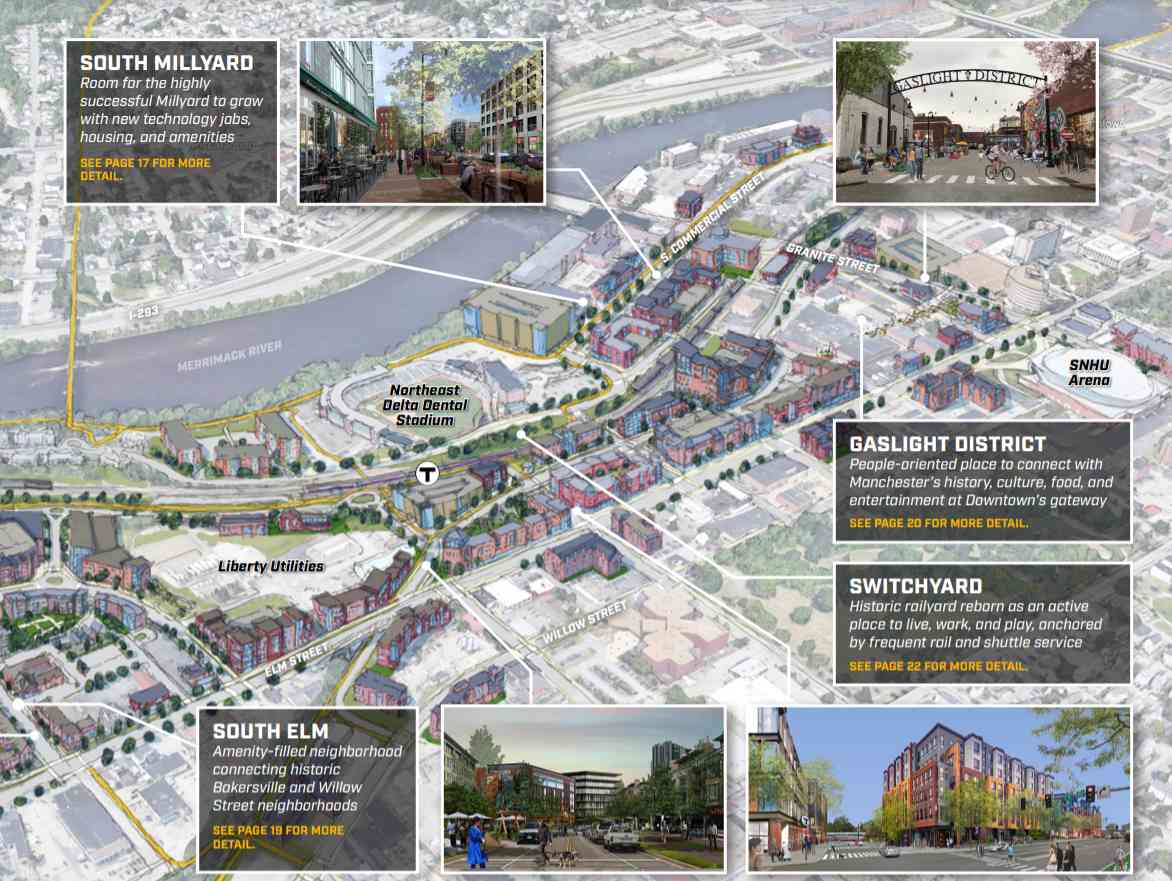
MANCHESTER, NH – The Transit Oriented Development (TOD) Plan for a mixed-use community within walking distance to public transport in the South Elm Street area was the focus Wednesday of a panel discussion.
Last year, Southern New Hampshire Planning Commission (SNHPC) contracted with GoodyClancy to come up with a proposal for the area from Elm Street, at Granite Street, to Queen City Avenue to Second Street.
For about a year, the consultants gathered input from the public and collected data to come up with the plan that includes 1,800 residential units along with various retail businesses.
James Vayo, project manager for SNHPC and host of Wednesday’s Zoom panel discussion, said the idea is to provide housing within walking distance of public transport, particularly for people who work downtown. He likened it to Assembly Row in Somerville, Mass., which features numerous apartments above retailers and restaurants, with the Massachusetts Bay Transportation Authority station a short walk away.
On Wednesday, Ben Carlson and Kathleen Onufer of GoodyClancy gave an overview of the proposal which would be built over 10 to 20 years.
It calls for centering a railroad station over the tracks behind Firestone Tire. Carlson said PanAm Railways is interested in selling land they are not using.
Southern Elm Street, near Valley Street, could become a hub of activity with a rail station, according to GoodyClancy.
⇒ Manchester Transit-Oriented Development Plan – info, maps and timeline
WATCH The Oct. 28 presentation below
Bringing rail service to the city is a contentious issue, one that has been talked about for decades. Mike Whitten, executive director of the MTA and a panelist, said “it’s only a matter of when” rail service reaches Manchester. “You can only expand (I-)93 so many times,” he said.
Panelist Elizabeth Hitchcock of Orbit Group said the biggest problems facing developers are zoning regulations and requirements regarding parking and planning.
She said one of the businesses she is involved with is interested in robotic manufacturing. Hitchcock wants to find a way to make Manchester the hub for robotic manufacturing in the state, if not the region.
However, she said right now development costs are so high that she would like to see a plan where taxes could be put off for a longer period of time.
Hitchcock said the city is like a business with taxes as its only revenue. With a tax cap, she explained, the only way to increase revenue is through development.
According to the GoodyClancy plan, a $125 million investment in street, recreational paths and parking infrastructure and a frequent shuttle service, would ultimately result in $600 million in new real estate development. It amounts to a $4 private investment for each $1 of public investment.
Property in downtown Manchester, Carlson said, is 3 ½ times more valuable per acre then in the rest of the city.
Onufer said the plan includes new roads, sidewalks and improvements to the Riverwalk. It also calls for upgrading the transit service to the highest quality possible.
Whitten said 15-year-old buses already were replaced, shuttles run regularly to the Southern New Hampshire University campus on River Road, the University of New Hampshire and the Institute of Art. There are buses operating until 9:30 or 10 p.m. four nights a week. Previously, service stopped at 6:30 p.m.
There is also a smart phone app that can be downloaded to let riders know when a bus will be arriving which is helpful in winter. “You can get a cup of coffee and come out a couple of minutes before the bus is due to arrive,” he said.
Property values go up when there is high quality, frequent transit, according to Onufer.
Carlson said the TOD area is not only valuable as real estate but what it also means is “lots of jobs.”
Housing affordability is an issue, however.
Jimmie Hinson of the N.H. Department of Business and Economic Affairs said that bio-medical is going to be big in the city and that housing has got be affordable for LPNs and other workers so they do not have to commute two to three hours a day to get to their jobs.
Vayo said they reached out to NeighborWorks Southern New Hampshire, which works to eliminate blight and develop high quality, affordable rental units, to address that issue.
He said an investment in transit will help the city meet its maximum potential.
At some future date, the city’s planning board will be presented the plan for consideration as a supplement to its master plan which is being worked on.
You can review the TOD plan below.







